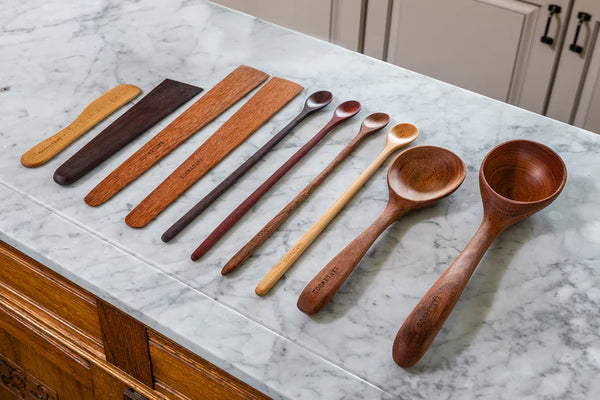What I've got laying here is a three large flat sautes. We've got one jatoba, one mexican ebony and one bloodwood. None of these have been oiled for probably a solid year and these are my own utensils and I treat them as hard and as badly as I can just to see if they can take it. I don't expect yours to look this bad because I treat mine horribly (laughs), but what I'm gonna do here is oil one of these up. Probably this Mexican ebony right here and I'm gonna use this little guy which is a little chunk of scotch-brite that came with your order.
It says woodcare on the front and it actually has the instructions for taking care of it on the back. It's actually no different than the green side of a regular kitchen sponge so if you lost this or threw it away or already used it you can always use the back side. And it's a good idea to always use the back side of your sponge when you're washing these anyways because what it does is it constantly just takes off the tiniest little layer of material there and there's no stain or anything on these they're this color all the way through. So if you're constantly taking off a layer you're just constantly exposing a brand-new layer of wood so it'll keep them looking great for years.
So what you want to do is start with a dry utensil if it's not dry let it sit out overnight or so and take this scotch-brite and just rub it as hard as you can. In the direction of the grain is the best way to do it. Yeah if there's any little fuzz on the utensil or whatnot this will take it right off and get it feeling nice and smooth. You might get some sawdust coming off of there it's basically kind of just like a piece of sandpaper that's really fine grit so we'll get both ends of it and then I'm gonna get the edges too. You can see the dust landing on the table there that's normal so then you want to just clean all that dust off of there. I got a bunch on the table.
You're gonna want to take your wood oil which is all food-safe mineral oil with a little bit of lemon peel oil in there to make it smell good and I just pour it right on there. And I am working it in with my fingers and this stuff never dries and never forms of coatings. So you want to get as much as you can on there and leave it on there as long as you can to get everything soaked in that you can. What the oil does is just a it makes it look better as you can see already but the most important thing about oiling wood is wood oil repels water and it's the soaking up and drying out of water that wrecks wooden utensils. Just like it does on a street you know when like a street soaks up water and ices over and then thaws out it will crack a street. It will do the same thing to wood so the best thing to do here is get as much oil on it as you can and let it sit there hopefully overnight. And that's pretty much the best thing to do, if it's really dry you'll come back in the morning and there you won't see any of this shiny liquid anymore that means it all soaked in because it doesn't dry. For this case, I'm just gonna go ahead and dry this off and if you just want them to look better for a party or something just throw a little on there let it sit for just a second and wipe it off and that's all it takes. She's totally done, you can see it pretty much looks exactly like a new one.




